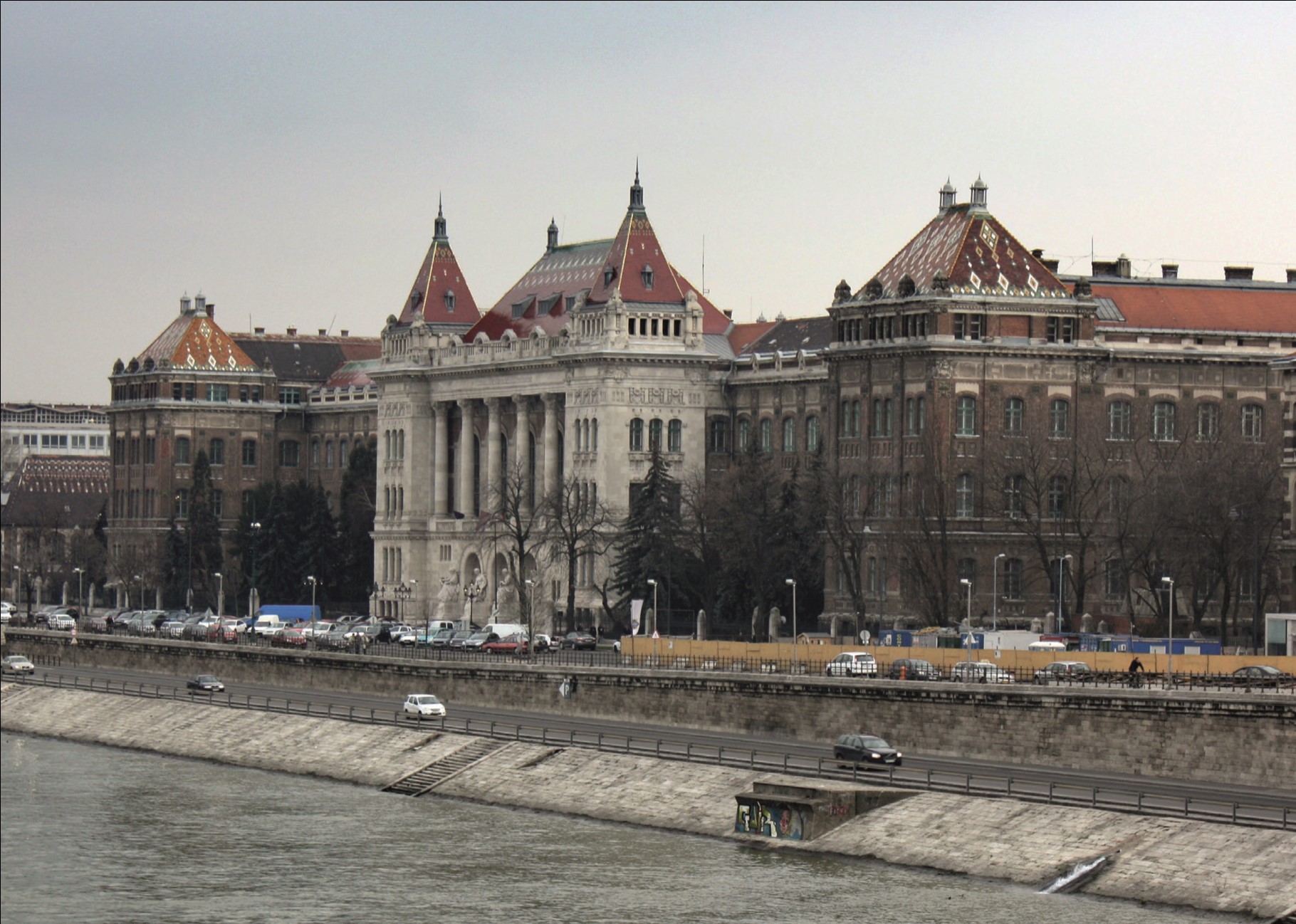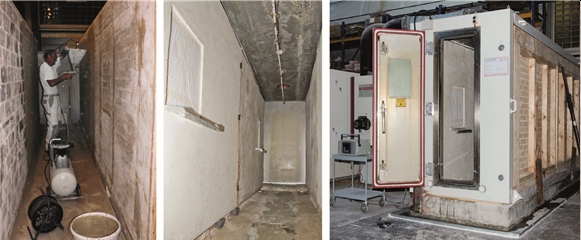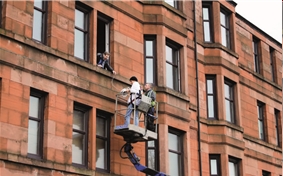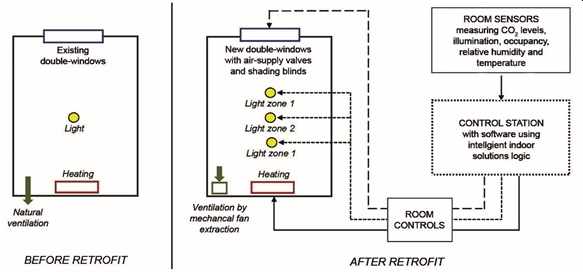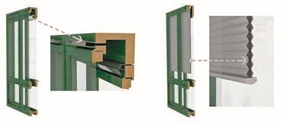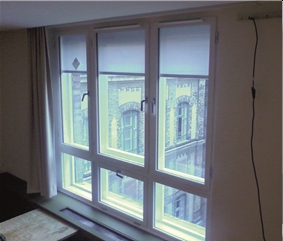Retrofit measures for historic buildings and cities
This article originally appeared in Context 142, published by The Institute of Historic Building Conservation in November 2015. It was written by Carsten Hermann and Dennis Rodwell.
An EU project is researching the energy efficiency and sustainability of European historic urban districts, and investigating measures and tools to make significant improvements.
[image: Budapest University of Technology and Economics, the case study building for the advanced double window system (Photo: Dennis Rodwell)]
EFFESUS (the acronym for ‘Energy Efficiency for EU Historic Districts’ Sustainability’) is a European research project focused on energy efficiency improvements at the scale of historic districts that are compatible with the protection of their heritage value. Co-funded by the European Commission [1], the four-year project, involving 23 partners from 13 countries, runs until next year.
From the outset, the EFFESUS project recognised that economies of scale could best be envisioned by looking beyond the limited extent of the designated heritage (which varies, by country, at between two and four per cent of the buildings), and addresses the over 23 per cent of the European building stock that was built before 1945 – the cut-off date used in EFFESUS. This maximises the energy-efficient and creative reuse potential of a broad definition of urban heritage, thereby allowing the easy transfer of retrofit technologies and an upscaling of adaptation measures. Furthermore, many suitable technologies for renewable energy generation and energy management only become feasible at an urban scale, irrespective of whether individual components or areas are designated as heritage.
The overall objectives of the EFFESUS project are threefold: to develop a variety of technologies specifically suitable for use in historic districts; to build a software tool to support strategic decision-making; and to deliver education and training on the retrofitting of historic urban districts and their buildings. The retrofit measures that are being developed fall into three strands: technologies to retrofit building fabric and building services; advanced systems for energy management; and systems to generate energy from renewable sources within historic cities. All technological developments under the EFFESUS project are being trialled in real-world case studies in seven historic cities across Europe: Benediktbeuern (south of Munich), Budapest, Genoa, Glasgow, Istanbul, Santiago de Compostela and Visby.
Of the manifold retrofit measures, this article concentrates on three measures that are especially suitable in a British context: first, an insulating lime mortar, for use externally as render or internally as plaster; second, an aerogel fibre insulation to infill cavities behind existing wall finishes, such as plaster on laths or plasterboard dry-lining; and, third, an advanced window system with integrated air supply valves and shading blinds connected to a building management system. All three measures have now been installed in case study buildings in Benediktbeuern, Glasgow and Budapest, with the support of the local consortium partners, the French building conservation firm SAS Gouas, the British heritage consultant Dennis Rodwell and the Irish energy efficiency consultant DWEcoCo Ltd.
For EFFESUS, a new insulating lime mortar was developed by the Dutch partner Bofimex. Various insulating mortars were considered at the start of the EFFESUS project, of which none was based on a lime binder. Whereas the inherent material properties of lime mortars, especially their lower strength development and higher vapour permeability and moisture absorption compared to cement-based mortars, make them particularly suitable for use with historical masonry, their thermal insulating properties are deficient.
The Bofimex mortar, ISOCAL, is based on natural hydraulic lime (NHL), combined with extruded polystyrene beads as insulant and other additives. As mortar, an NHL 5 is used, which is a higher-strength mortar in the NHL range. However, because the polystyrene filler content is up to 80 per cent, the resulting mortar is substantially weaker and more permeable than ordinary NHL 5 mortars, making the new product better suited for use as render and plaster for historical masonry.
The new mortar was trialled first in the laboratories of the German consortium partner MPA Stuttgart, the material testing institute of the University of Stuttgart. A field trial was then conducted by another German partner, Fraunhofer-Gesellschaft, at the outdoor test site in Holzkirchen of their Institute for Building Physics, where a timber-framed test house already exists. The insulating render was applied to the west-facing wall, to a brick infill panel set into the timber frame. The performance measurements are continuing. The location in Bavaria’s Alpine foothills has, for Germany, harsh climatic conditions, with severe wind-driven rain exposure, high radiation heat losses during nights and frequent freeze-thaw cycles. The west-facing wall receives the extremes of weathering loads – the harshest test conditions for the applied mortar.
[Image: Spray application of insulating lime render on a wall forming the enclosure of a climate chamber (Photo: MPA Stuttgart)]
In parallel, the mortar has been applied as a plaster in the nearby case study in Benediktbeuern, at the Fraunhofer Centre for Conservation and Energy Performance of Historic Buildings, located in the historic cooperage of the town’s Baroque monastery. Here the plaster’s hygrothermal performance is being closely monitored under controlled climatic indoor conditions.
The Scottish product development is aerogel fibre insulation, formulated initially to meet the extreme conditions of outer space exploration. The new product, SpaceLoft, is produced by the consortium partner A Proctor Group (APG), using aerogel supplied by the American company Aspen Aerogel.
For EFFESUS, the prompt for developing this product related to the traditional use of plaster on laths as an internal wall finish, often to be found in Britain. This historical construction includes air cavities between the battens supporting the laths. Where these cavities are not required for moisture evaporation from the masonry, they can be filled by blowing in cavity-fill insulation. This installation process minimises time and costs as well as damage to existing fabric and disruption to building occupants. The retrofitting technique can also be used for cavities behind plasterboard drylining.
Existing cavity-fill products have limitations for use with older construction types, such as historical masonry, being vapour-impermeable or water-absorbent, having lower thermal performance or introducing the risk of plasticiser migration. The newly developed product is manufactured from non-woven blankets of polyester fibres impregnated with silica aerogel. Aerogel is a lightweight solid derived from a gel whose liquid component has been replaced with gas. When the liquid is removed, what remains is akin to puffed-up sand, with up to 99 per cent porosity. The result is an extremely low-density material with several remarkable properties, most notably its effectiveness as a thermal insulator that is ultra-light, extremely water repellent and vapour permeable.
As with the insulating lime mortar, the aerogel fibre insulation was tested first by MPA Stuttgart before, in early 2015, a real-world case study was set up in Glasgow, coordinated by Historic Environment Scotland (formerly Historic Scotland). APG has now installed the product in a 19th-century tenement flat, where it is being monitored.
[Image: The Italian partner RED installing equipment for heat-flow measurements of the aerogel retro-fitted wall in the Glasgow tenement case study (Photo: Historic Environment Scotland)]
Improving the performance of windows is typically restricted to simplistic measures such as draught-proofing and double glazing, without regard to a myriad of associated conditions. Double windows, typical of many regions of mainland Europe, already exist in the 19th century building of the Budapest University of Technology and Economics, situated on the Danube riverbank. For teaching rooms in this building, EFFESUS has developed an advanced window system with in-built air supply valves and shading blinds, both connected to a building management system. The window development is a collaboration between the Hungarian architectural firm HorBer, the Norwegian University of Science and Technology (NTNU), DWEcoCo and Snekkeriet, a Norwegian joinery company. The building management system was developed and coordinated by the Italian partner RED Srl.
The new double windows replace existing windows and are fitted with slim-profile, high-performance double- and triple-glazing units. Integrated into the 150mm-wide space between the inner and outer casements are motorised shading blinds. Special air supply valves are fitted into both the inner and outer window frames. Air pressure and temperature differences create a passive air flow. Outdoor air is drawn into the space in between the frames and pre-heated by the heat transfer through the window glass before entering the room, improving the window’s energy efficiency significantly. If the indoor carbon dioxide levels increase above a set threshold, the building management system activates a mechanical exhaust fan in the room. This, in turn, increases the pressure difference, thereby accelerating the air flow through the air supply valves in the window frames. This mix of passive and active ventilation improves the indoor air quality while minimising associated energy losses.
The shading blinds integrated into the windows are managed by daylight sensors connected to the building management system to control solar glare, solar heat gain and the ambient lighting conditions. When the shading in the windows is lowered to prevent overheating due to solar gain, the building management system responds to information from illumination and occupancy sensors to activate the lighting. The system can be manually overridden, for example if a darkened room is required for presentations. The building management system also controls a motorised radiator valve which modulates the heat output in the room to maintain comfortable conditions.
The three technological developments presented here are all being monitored in the case studies by RED, together with another Italian project partner the Institute of Atmospheric Sciences and Climate of the National Research Council. Evaluation results will be available in time for the completion of the project in the summer of 2016. The industry partners in the EFFESUS consortium are in the process of developing business models to exploit the new product developments.
[Image: Set-up of building services in the test room of the Budapest case study before and after retrofit: the building management system is connected to the window blinds and air supply valves, radiator valves, the lighting and various sensors (Image: Historic Environment Scotland and RED)]
[Image: Integration of air supply valves and shading blinds into the double windows developed for the Budapest case study buildings (Image: NTNU)]
[Image: Replacement double-window systems, with air supply valves and integrated shading blinds linked to a building management system (Photo: NTNU)]
References
- [1] The EFFESUS research project receives funding from the European Union’s Seventh Framework Programme for research, technological development and demonstration. This article reflects the authors’ views and the European Union is not liable for any use that may be made of the information contained.
Carsten Hermann is a senior technical officer at Historic Environment Scotland. Dennis Rodwell, an architect-planner, is a consultant in cultural heritage and sustainable urban development.
--Institute of Historic Building Conservation
Related articles on Designing Buildings Wiki
- Aerogel.
- Decision support for energy improvements.
- Ecobuild 2016 - Making the business case for large scale retrofit investment.
- New energy retrofit concept: 'renovation trains' for mass housing.
- Renovation v refurbishment v retrofit.
- Retrofit.
- Retrofit coordinator.
- Retrofit, refurbishment and the growth of connected HVAC technology.
- The Each Home Counts report and traditional buildings.
- The New Tenement: residences in the inner city since 1970.
- Upcycling.
- Visby as a historic urban landscape.
IHBC NewsBlog
Heritage Building Retrofit Toolkit developed by City of London and Purcell
The toolkit is designed to provide clear and actionable guidance for owners, occupiers and caretakers of historic and listed buildings.
70 countries sign Declaration de Chaillot at Buildings & Climate Global Forum
The declaration is a foundational document enabling progress towards a ‘rapid, fair, and effective transition of the buildings sector’
Bookings open for IHBC Annual School 12-15 June 2024
Theme: Place and Building Care - Finance, Policy and People in Conservation Practice
Rare Sliding Canal Bridge in the UK gets a Major Update
A moveable rail bridge over the Stainforth and Keadby Canal in the Midlands in England has been completely overhauled.
'Restoration and Renewal: Developing the strategic case' Published
The House of Commons Library has published the research briefing, outlining the different options for the Palace of Westminster.
Brum’s Broad Street skyscraper plans approved with unusual rule for residents
A report by a council officer says that the development would provide for a mix of accommodation in a ‘high quality, secure environment...
English Housing Survey 2022 to 2023
Initial findings from the English Housing Survey 2022 to 2023 have been published.
Audit Wales research report: Sustainable development?
A new report from Audit Wales examines how Welsh Councils are supporting repurposing and regeneration of vacant properties and brownfield sites.
New Guidance Launched on ‘Understanding Special Historic Interest in Listing’
Historic England (HE) has published this guidance to help people better understand special historic interest, one of the two main criteria used to decide whether a building can be listed or not.
"Conservation Professional Practice Principles" to be updated by IHBC, HTVF, CV
IHBC, HTVF, and CV look to renew this cross-sector statement on practice principles for specialists working in built and historic environment conservation roles.








